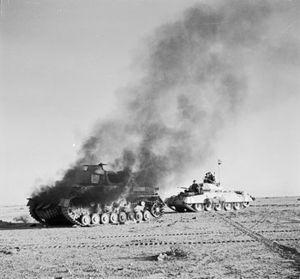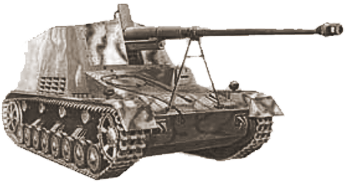Operation Crusader

In November 1941, a lull in the year long battle between the Axis and British Commonwealth forces fighting across the North African desert finally allowed both sides to recover their strength. German General Erwin Rommel's command fielded 414 tanks, 173 German, and nine divisions (including two German divisions; the 5th Light - renamed the 21st Panzer Division on October and 15th Panzer Division) with 320 aircraft providing direct close air support. The British led Allied army however had become even stronger than it had been the previous spring and put over 700 tanks, including 300 American made Stuart light tanks, 300 Crusaders, 170 Matildas, eight divisions and 1,000 aircraft into the field. The Stuart possessed inadequate armament, with a 37mm gun that however stood up well against the German Mark II tanks; if not as well against the Mark III and IV tanks also equipping Rommel's panzer divisions. The Stuart's primary strength stemmed from her formidable speed and maneuverability. British tank commanders quickly learned they needed to close with the German tanks to knock them out, and relied heavily on the Stuart's speed in combat to fire and then vigorously maneuver into the next firing position. Led by their fast Stuart's and Crusader's this grouping of armor comprised the primary striking power of the British Eighth Army which at the time featured two corps; the XXX Corps and XIII Corps. In addition, British defenses at the besieged Libyan port of Tobruk had been bolstered on August 18th with the arrival of the fresh and highly motivated Polish Independent Carpathian Brigade, a 3,000-man force comprised of members of the Polish Army who had managed to escape from Poland in the fall of 1939.
On November 18th the British Commonwealth forces, led by General Alan Cunningham, sought to take advantage of not only their superiority in numbers but an Axis command still distracted by events at Tobruk. Cunningham's offensive, code-named Crusader, sought to engineer a break out from Tobruk as the Eighth Army sent XXX Corps to outflank Rommel's forces further inland; just across the Libyan border with Egypt and hopefully causing Rommel to commit his own armor to attacking the heavily armored XXX Corps. The plan presupposed this would allow the British to destroy Rommel's armor as at the same time the infantry heavy XIII Corps dismantled the Axis main line and penetrated to Tobruk. Chaotic fighting characterized Crusader and the swirling nature of the war in the desert, where mobility meant everything. Thus, in a running several week long battle Rommel was able to again frequently demonstrate his tactical skill in deploying his infantry, anti-tank weapons and armored reserves in a coordinated effort, frequently massed for even greater firepower, often deployed flexibly wherever needed on this incredibly fluid battlefield. That said, several questionable deployments by German officers, including Rommel's ill advised "dash to the wire" sapped the Axis armies strength. For their part, the British persisted in spreading out their armor, to either protect the infantry or operate independently, and thus greatly diminished Allied numerical advantage at key junctions in the battle. Overall however, the British were able to wear down the Axis forces and by December 7th Rommel had ordered his exhausted army to begin a long retreat, with Major General Neil Ritchie's forces nipping at his heels. Ritchie however also commanded a drained army. Therefore, he could not maintain an effective pursuit. During five weeks of combat the British 4th Armored Brigade alone, which had fought continuously during Crusader's first two weeks, lost 172 tanks from an initial strength of 163 tanks. Rommel thus stayed ahead of the advancing British, and avoided encirclement as he fell back on his shortening supply lines. Nevertheless for the first time in the North African desert Rommel had been defeated.
by Steven Douglas Mercatante



Post new comment